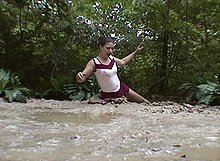

Quicksand may be escaped by slow movement of the legs in order to increase viscosity of the fluid, and rotation of the body so as to float in the supine position (lying horizontally with the face and torso facing up). sun stroke), dehydration, hypothermia, drowning in a rising tide or predatory animals may harm a trapped person. Since this increasingly impairs movement, it can lead to a situation where other factors such as weather exposure (i.e. Ĭontinued or panicked movement, however, may cause a person to sink further in the quicksand. Aluminium, for example, has a density of about 2.7 grams per cubic centimeter, but a piece of aluminium will float on top of quicksand until motion causes the sand to liquefy. Even objects with a higher density than quicksand will float on it if stationary. At that level of density, sinking beyond about waist height in quicksand is impossible.

Quicksand has a density of about 2 grams per cubic centimeter, whereas the density of the human body is only about 1 gram per cubic centimeter. It is impossible for a human to sink entirely into quicksand, due to the higher density of the fluid. The forces required to do this are quite large: to remove a foot from quicksand at a speed of 1 cm/s would require the same amount of force as that needed to lift a car. To move within the quicksand, a person or object must apply sufficient pressure on the compacted sand to re-introduce enough water to liquefy it. Someone stepping on it will start to sink. After an initial disturbance-such as a person attempting to walk on it-the water and sand in the quicksand separate and dense regions of sand sediment form it is because of the formation of these high volume fraction regions that the viscosity of the quicksand seems to decrease suddenly. Quicksand is a shear thinning non-Newtonian fluid: when undisturbed, it often appears to be solid (" gel" form), but a less than 1% change in the stress on the quicksand will cause a sudden decrease in its viscosity (" sol" form). Quicksand warning sign near Lower King Bridge, Western Australia The movement combined with an increase in pore pressure (of groundwater) leads to the loss of particle cohesion, causing buildings or other objects on that surface to sink. Soil liquefaction may occur in partially saturated soil when it is shaken by an earthquake or similar forces. Objects in liquefied sand sink to the level at which the weight of the object is equal to the weight of the displaced soil/water mix and the submerged object floats due to its buoyancy. The cushioning of water gives quicksand, and other liquefied sediments, a spongy, fluid-like texture. This causes the sand to form a suspension and lose strength.

The saturated sediment may appear quite solid until a sudden change in pressure or shock initiates liquefaction. In the case of upward flowing water, forces oppose the force of gravity and suspend the soil particles. Quicksand can form in standing water or in upward flowing water (as from an artesian spring). When water in the sand cannot escape, it creates a liquefied soil that loses strength and cannot support weight. It forms in saturated loose sand when the sand is suddenly agitated. Quicksand is a colloid consisting of fine granular material (such as sand, silt or clay) and water.


 0 kommentar(er)
0 kommentar(er)
